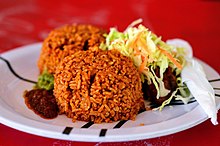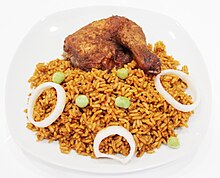Jollof rice
 Jollof rice with stew and garnish | |
| Alternative names | Benachin, riz au gras, ceebu jën, zaamè |
|---|---|
| Type | Rice dish |
| Course | Main course |
| Region or state | West Africa[1][2] |
| Serving temperature | Hot |
| Main ingredients | Rice, tomatoes and tomato paste, onions, chili peppers, cooking oil |
| Ingredients generally used | Herbs, spices, aromatics |
| Variations | Various meat and seafood versions |
Jollof (/dʒəˈlɒf/), or jollof rice, is a rice dish from West Africa. The dish is typically made with long-grain rice, tomatoes, chilies, onions, spices, and sometimes other vegetables and/or meat in a single pot, although its ingredients and preparation methods vary across different regions. The dish's origins are traced to Senegal.[3]
Regional variations are a source of competition between the countries of West Africa, and in particular Nigeria and Ghana, over whose version is the best; in the 2010s this developed into a friendly rivalry known as the "Jollof Wars".
In French-speaking West Africa, a variation of the dish is known as riz au gras.
History and origin[edit]
According to African food historian Fran Osseo-Asare, the origins of the dish can be traced to north Senegal, which was ruled by the Wolof or Jolof Empire in the 14th century, spanning parts of today's Senegal, The Gambia and Mauritania, where rice was grown,[2] and which is known as thieboudienne or thiebou djeun,[4] which contains rice, fish, shellfish and vegetables.[5] If made with meat, it is called cheeb u yapp.[2]
Food and agriculture historian James C. McCann speculated that it was unlikely that the dish could have naturally spread from Senegal to its current range since a similar cultural diffusion is not seen in "linguistic, historical or political patterns". Instead, he proposed that the dish spread with the Mali empire, especially the Djula tradespeople who dispersed widely to the regional commercial and urban centers, taking with them economic arts of "blacksmithing, small-scale marketing, and rice agronomy" as well as the religion of Islam.[2]
Marc Dufumier, an emeritus professor of agronomy, proposes a more recent origin for the dish, which may only have appeared as a consequence of the colonial promotion of intensive peanut cropping in central Senegal for the French oil industry, and where commensurate reduction in the planted area of traditional millet and sorghum staples was compensated for by imports of broken rice from Southeast Asia. This gave local cooks no choice but to use the then-unfamiliar product.[6]
The use of New World tomatoes, tomato paste, capsicum peppers (bell, chili, paprika), Indian curry powder, Mediterranean thyme, and Asian rice varieties, may limit the origin of the current dish to no earlier than the 19th century, there being no evidence of the ingredients being locally cultivated or imported before this period.[7][8] In Senegal, oral histories credit Penda Mbaye, a cook at the residence of one of the colonial rulers in Saint-Louis, Senegal, as having created the dish when she ran out of barley and substituted rice.[8][6][9]
Geographical range and variants[edit]
Jollof rice is one of the most common dishes in West Africa. There are several regional variations in name and ingredients;[1] for example, in Mali it is called zaamè in Bamanankan. The dish's most common name of Jollof derives from the name of the Wolof people,[10] though in Senegal, Mauritania and Gambia the dish is referred to in Wolof as ceebu jën or benachin. In French-speaking areas, it is called riz au gras. Despite the variations, the dish is "mutually intelligible" across the regions and has become the best known African dish outside the continent.[2][11][12][13][14] It is found throughout the world wherever communities of West African immigrants have developed.[11]
Ingredients and preparation[edit]

Jollof rice traditionally consists of rice, cooking oil, tomatoes, onion, chilies, and often some combination of other ingredients such as tomato paste, bell pepper, garlic, ginger, thyme, curry powder, grains of selim, and bouillon cubes or stock; recipes vary from country to country and cook to cook. Chicken, turkey, beef, lamb or fish are often cooked with or served with the dish.[15][16][5] In some countries, other vegetables such as cabbage or carrots are included.[17]
Some recipes call for long grain rice, some for short grain, some for broken rice, others for parboiled rice.[18][17] Typically the tomatoes, paste, onions, and chilis are sauteed in oil and simmered into a sauce which the rice is then cooked in.[4][18]
Jollof wars[edit]

West African countries typically have at least one variant form of the dish, with Ghana, Nigeria, Sierra Leone, Liberia and Cameroon particularly competitive as to which country makes the best jollof.[5] In the mid-2010s this expanded into the "Jollof Wars".[19]
The gastronationalistic rivalry is especially prominent between Nigeria and Ghana.[20][21] In 2016, Sister Deborah released the song "Ghana Jollof", which denigrated the Nigerian version and Nigerians for being proud of their version.[22] Soon after, a physical fight over insufficient jollof supplies at a Ghanaian political rally sparked delighted mocking of Ghanaians by Nigerians.[22]
Of particular sensitivity in jollof-making communities is the inclusion of non-traditional ingredients, which are defined country to country and are seen as making the jollof inauthentic.[22][5] In 2014, a recipe released by Jamie Oliver that included cherry tomatoes, coriander, lemon, and parsley, none of which are used in any traditional recipe, caused outraged reactions to the point Oliver's team had to issue a statement.[22]
Regional variations[edit]
Ghana[edit]

Ghanaian jollof rice is made of vegetable oil, onion, ginger, pressed garlic cloves, chillies, tomato paste, beef or goat meat or chicken (sometimes alternated with mixed vegetables), local or refined rice, typically jasmine rice and black pepper.[23] Ghanaian jollof typically does not include any green leafy vegetables.[22]
The method of cooking Ghanaian jollof begins with first preparing the beef or chicken by seasoning and steaming it with a pureé of ginger, onions and garlic and frying it until it is well-cooked.[23] The rest of the ingredients are then fried all together, starting from onions, pepper, tomato paste, tomatoes and spices in that order. After all the ingredients have been fried, rice is then added and cooked until the meal is prepared. Ghanaian jollof is typically served with plantains and side dishes of beef, chicken, well-seasoned fried fish, or mixed vegetables.[22][24][25]
Jollof in Ghana is also served alongside shito, a popular type of pepper which originates from Ghana, and salad during parties and other ceremonies.[26]
Liberia[edit]
Liberian jollof seldom includes seafood.[22]
Nigeria[edit]

| This article is part of a series in |
| Culture of Nigeria |
|---|
 |
Although considerable variation exists, the basic profile for Nigerian jollof rice includes long-grain rice (including golden sella basmati rice), tomatoes and/or tomato paste, onions, pepper (chilli, scotch bonnet and bell pepper), vegetable oil, meat broth/stock and a various mixture of additional ingredients, including thyme, bay leaves, curry powder, white pepper, (small amounts of) nutmeg and stock cubes.[4] Converted rice, which may respectively exist in the form of standard long-grain parboiled rice (often labelled as easy-cook rice in the U.K.[27]) or Golden Sella basmati rice (similarly-parboiled[28] and which has come to be especially commonly-used in the U.K., gradually increasing in popularity since 2006) is most-appropriate for Nigerian one-pot rice-cooking, as it resists becoming mushy.[18]
The important quality of rice used to cook Nigerian one-pot rice recipes, including jollof rice, is that it is parboiled. The decision whether to use any of the numerous brands of conventional long-grain parboiled/easy-cook rice (e.g., Tolly Boy, Veetee, Village Pride, Tropical Sun, Mama Pride, Mama Africa, Cap Rice, Uncle Ben’s, Royal Stallion, Carolina Gold) or Golden Sella basmati-parboiled rice (further sub-branded, e.g., Asli, Tilda) is merely a matter of availability, convenience and/or personal preference and the sub-status of one or the other grain-group being conventional long-grain or basmati long-grain completely irrelevant. What matters is that it is parboiled (i.e., partially boiled at the husk when processing). Sella basmati rice, however, is considered more aesthetically pleasing to some.[29]
Most of the ingredients are cooked in one pot, of which a rich meat stock or broth and a fried tomato and pepper puree characteristically forms the base. Rice is then added and left to cook in the liquid.[4]
The dish is then served with the protein of choice (which in theory may be any meat but often beef, turkey, chicken or croaker-fish; much less commonly lamb, pork, etc.) and very often with fried plantains, moi-moi, steamed vegetables, coleslaw, salad, etc.[30]
Sierra Leone[edit]
The dish is known in Sierra Leone, where it may not call for red palm oil but, instead, tomato paste,[18][2] similar to the rest of ‘jollof-cooking’ West Africa.
Riz au gras[edit]
In French-speaking West Africa, including Beninese, Burkinabé, Guinean, Guinea-Bissauan, Ivorian, Nigerien, and Togolese cuisines, there is a variant called riz gras or riz au gras, which translates to "fat rice", a reference to the short-grain rice usually used in the dish.[18] Riz gras typically includes additional vegetables such as eggplant, carrots, and/or cabbage. [31][32][33]
Cultural importance and worldwide popularity[edit]
Jollof is culturally important in much of West Africa to the point there is a common saying, "A party without Jollof is just a meeting".[18] In Nigeria the term, "See Jollof" means "see how much fun is being had" according to Nigerian food historia Ozoz Sokoh.[18]
Since the 2010s there has been increasing interest in West African foods in the western world. Jollof food festivals have been held in Washington, DC, and Toronto. "World Jollof Day" has been celebrated since 2015 on 22 August, gaining traction on social media.[5][18] On 3 November 2022, the dish was honoured with a Google Doodle.[34]

Related dishes[edit]
Some areas also have versions of two related dishes:
- Party jollof or party rice is generally cooked outdoors over a wood fire, which gives it a smoky flavor and a crusty "bottom pot" similar to tahdig or socarrat.[18][17]
- Native rice, which uses red palm oil and smoked, dried fish and is seasoned with uziza seeds and/or scent leaf,[18] (respectively known as nchuanwu, arimu and ahuji in Igbo; ntong in Efik-Ibibio; effirin in Yoruba, añyeba in Igala, aramogbo in Edo; etc.), occasionally sprinkled with cut olili (local mint). Concoction rice is a term that may refer to either this or an ‘economically-friendly’ version of either this or conventional jollof rice but in the latter, too, red palm oil (or groundnut oil) is more frequently used to cook it than vegetable oils.
See also[edit]
References[edit]
- ^ a b Ayto, John (2012). "Jollof rice". The Diner's Dictionary: Word Origins of Food and Drink (2nd ed.). Oxford University Press. p. 188. ISBN 978-0199640249.
- ^ a b c d e f McCann, James C. (2009). A west African culinary grammar". Stirring the Pot: A History of African Cuisine. Ohio University Press. pp. 29, 133–135. ISBN 978-0896802728.
- ^ "Request Rejected". ich.unesco.org. Retrieved 31 March 2024.
- ^ a b c d Komolafe, Yewande (24 June 2019). "Yewande Komolafe's 10 Essential Nigerian Recipes". The New York Times. ISSN 0362-4331. Retrieved 18 September 2023.
- ^ a b c d e Sloley, Patti (7 June 2021). "Jollof Wars: Who does West Africa's iconic rice dish best?". BBC Travel. Retrieved 16 July 2021.
- ^ a b Dufumier, Marc (30 March 2018). "Recette : le thiéboudiène de Marc Dufumier". Le Monde. Retrieved 27 October 2018.
- ^ Alpern, Stanley B. (1992). "The European Introduction of Crops into West Africa in Precolonial Times". History in Africa. 19: 13–43. doi:10.2307/3171994. ISSN 0361-5413. JSTOR 3171994. S2CID 163106670.
- ^ a b Kokayi, Saqera (18 March 2021). "The History of Jollof Rice". Best of Vegan. Retrieved 15 May 2023.
- ^ Afana, Clementine (31 March 2020). "Senegalese Thieboudienne Is a Dish That Feeds, Satisfies, and Unites". Matador Network. Retrieved 18 September 2023.
- ^ Osseo-Asare, Fran (1 January 2005). Food Culture in Sub-Saharan Africa. Greenwood Publishing Group. pp. 33, 162. ISBN 978-0-313-32488-8.
- ^ a b Davidson, Alan (11 August 2014). "Jollof rice". The Oxford Companion to Food. Oxford University Press. p. 434. ISBN 978-0-19-967733-7.
- ^ Brasseaux, Ryan A.; Brasseaux, Carl A. (1 February 2014). "Jambalaya". In Edge, John T. (ed.). The New Encyclopedia of Southern Culture: Volume 7: Foodways. University of North Carolina Press. p. 188. ISBN 978-1-4696-1652-0.
- ^ Anderson, E. N. (7 February 2014). Everyone Eats: Understanding Food and Culture, Second Edition. NYU Press. p. 106. ISBN 978-0-8147-8916-2.
- ^ "Ghana Jollof Recipe: Steps To Preparing Jollof Rice The Ghanaian Way". BuzzGhana. 5 September 2017. Retrieved 16 January 2020.
- ^ "Classic Nigerian Jollof Rice Recipe on Food52". Food52. Retrieved 27 February 2021.
- ^ "Ghana Jollof Recipe: Steps To Preparing Jollof Rice The Ghanaian Way". BuzzGhana. 5 September 2017. Retrieved 16 January 2020.
- ^ a b c Sokoh, Ozoh (22 September 2022). "Nigerian Jollof Rice Recipe". Serious Eats. Retrieved 18 September 2023.
- ^ a b c d e f g h i j Sokoh, Ozoz (10 May 2021). "The Wide World of Jollof Rice". Food & Wine. Retrieved 18 September 2023.
- ^ "West Africa steams over jollof rice war". BBC News. 25 August 2017. Retrieved 18 September 2023.
- ^ "Know the Differences Between Nigerian and Ghanaian Jollof Rice". Demand Africa. 4 July 2018. Retrieved 11 July 2021.
- ^ Adam, Hakeem (20 January 2017). "A Brief History of Jollof Rice, a West African Favourite". Culture Trip. Retrieved 16 January 2020.
- ^ a b c d e f g Egbejule, Eromo (22 August 2016). "World Jollof Day: Jamie Oliver's #ricegate and other scandals". The Guardian. ISSN 0261-3077. Retrieved 18 September 2023.
- ^ a b "Ghana: Jollof Rice". The African Food Map. Retrieved 15 November 2016.
- ^ Sekibo, Kojo (14 January 2020). "Traditional Ghanaian Jollof Rice Recipe". Yen.com.gh. Retrieved 16 January 2020.
- ^ "Ghana Jollof Recipe: Steps To Preparing Jollof Rice The Ghanaian Way". BuzzGhana. 5 September 2017. Retrieved 18 May 2021.
- ^ Sekibo, Kojo (14 January 2020). "Traditional Ghanaian Jollof Rice Recipe". Yen.com.gh. Retrieved 16 January 2020.
- ^ Reddy, K.R.N., Abbas, H.K., Abel, C.A., Shier, W.T., Oliveira, C.A.F.D. and Raghavender, C.R., 2009. Mycotoxin contamination of commercially important agricultural commodities. Toxin reviews, 28(2-3), pp.154-168.
- ^ Kaur, A., Virdi, A.S., Singh, N., Singh, A. and Kaler, R.S.S., 2021. Effect of degree of milling and defatting on proximate composition, functional and texture characteristics of gluten-free muffin of bran of long-grain indica rice cultivars. Food Chemistry, 345, p.128861.
- ^ Aneke, F.O., 2019. SENSORY EVALUATION OF JOLLOF RICE USING DIFFERENT TYPES OF RICE.
- ^ "How to cook Nigerian Jollof Rice". All Nigerian Recipes. Retrieved 16 January 2020.
- ^ Albala, K. (2011). Food Cultures of the World Encyclopedia [4 volumes]: [Four Volumes]. ABC-CLIO. p. 28. ISBN 978-0-313-37627-6.
- ^ Auzias, D.; Labourdette, J.P. (2013). Burkina-Faso 2014-2015 Petit Futé (avec cartes, photos + avis des lecteurs). Country Guides (in French). Petit Futé. p. 95. ISBN 978-2-7469-6947-6.
- ^ Trillo, R. (2008). The Rough Guide to West Africa. Rough Guides. p. pt817. ISBN 978-1-4053-8070-6.
- ^ Musil, Steven (3 November 2022). "Google Doodle Celebrates West Africa's Jollof Rice". CNET. Retrieved 4 November 2022.
External links[edit]
- Sister Deborah - Ghana Jollof (Music Video), retrieved 18 September 2023
